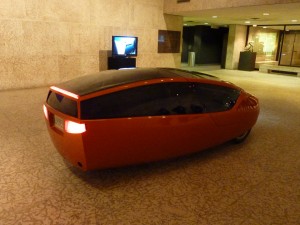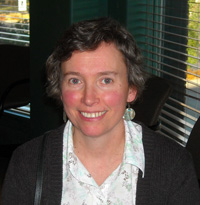Today’s (Oct. 25, 2011) next interview is with Maria DeRosa of the DeRosa Lab at Carleton University (Ottawa, Canada) where she and her colleagues work on bionanotechnology projects. (The Highlighting the 2011 Dance Your Ph.D. contest posting featured a Ph.D student from her lab who is one of this year’s contest finalists.)
Before proceeding to the interview, here’s a little bit about the DeRosa Lab (from the website homepage),
The first step in the rational design of novel bionanotechnology is to find the right molecular components for the task. Our group seeks to investigate the use of chemically-modified nucleic acid aptamers, single stranded DNA or RNA sequences that specifically bind to a diverse variety of targets, in biosensing and catalysis.
Here’s some information about Dr. DeRosa,
Dr. Maria DeRosa’s research examines a type of nucleic acid called ‘aptamers’ that can fold into 3D nanoscale shapes capable of binding tightly to a specific molecular target. Her group is focused on developing a better understanding of how these systems and using this information to design useful nanotechnology, like biosensors or “smart” delivery devices. Dr. DeRosa received her Ph.D in Chemistry from Carleton University in 2003 and was presented with a University Senate Medal. She was awarded an NSERC Postdoctoral Fellowship to do research at the California Institute of Technology from 2004-2005 with Prof. Jackie Barton, a world-leader in DNA sensor research. In 2005, she returned to Carleton as a faculty member in the Chemistry Department. Her research group has received funding from the Natural Sciences and Engineering Research Council (NSERC), the Ontario Ministry of Agriculture, Food and Rural Affairs (OMAFRA), the Canada Foundation for Innovation (CFI) and Alberta Innovates Biosolutions. DeRosa was a recipient of the John Charles Polanyi Research Award for new researchers in 2006 and an Ontario Early Researcher Award in 2010.
Here’s the interview,
* Are you one of those people who always wanted to be a scientist or was this something you discovered later?
I was never one of those people who knew what they wanted to do from an early age. I thought about being a doctor, pharmacist, plumber, engineer, bank teller… In high school, I had many great math and science teachers that inspired me to go into science when I started at Carleton University. Then, in my third year I got a summer job working in Dr. Bob Crutchley’s research lab. He was a great mentor and it was then that I started seriously thinking about a career as a scientist. I loved the idea of research, that I was working on a problem and no one knew what the answer would be. I wanted the answers!
* How did you get interested in aptamers (and could you briefly describe what they are)?
Aptamers are synthetic pieces of DNA that can recognize and stick to a molecular target. The targets can vary from things that are very small, like a drug molecule to something much larger, like bacteria or viruses. Because they can recognize and stick to other molecules, people are interested in using them as receptors for sensors. I had never even heard of them until about 2005.
After my Ph.D., I went to Caltech to do something called a postdoctoral fellowship. It was a research position in the lab of Dr. Jackie Barton, one of the world’s top DNA researchers (she just won a National Medal of Science a couple days ago). She wasn’t working with aptamers but she opened me up to the idea of using DNA in an “unnatural” way. Most of us, when we are thinking of DNA, we think of our genes and that it is the blueprint for life. But from a chemistry point of view, DNA is just another material that has certain chemical properties that can be useful for other applications. In Jackie’s lab, I learned how to make synthetic DNA and I started reading about aptamers. I found the whole field fascinating and I knew that I wanted to be a part of it.
* What applications are there for your work? (I noticed that you discussed fertilizers in your TEDxCarleton talk. Is agriculture an area of particular interest?)
Applications for aptamers mostly stem from their ability to bind tightly and selectively to other molecules. So, they are typically used in technology such as biosensors where they can serve to detect low levels of something, like a toxin or a virus for example, in another matrix. We’re developing aptamers for the detection of mycotoxins (toxins that come from moulds) in crops and food. We’re also working on aptamers for norovirus (the virus that causes Norwalk, that awful stomach bug) so that we can catch it if it is in meat and other foods before they get sent off to stores.
We are also trying to use aptamers for triggered delivery of drugs and/or nutrients. In many cases with drugs, we want them to act on certain cells or tissues and not on others. So, we need to be able to control where the drug is released in the body. There is a similar problem in agriculture. We want to give crops certain nutrients from fertilizers but if we deliver them at the wrong time, they will be washed away and not taken up by the crop. This leads to major economic losses for the farmer and problems for the environment. With our work, the idea is that we use the aptamer to control the release of whatever we are delivering. We incorporate the aptamer into a coating that covers the drug or nutrient. The aptamer is there to recognize a stimulus that we want to use to release the contents. For drug delivery, that stimulus might be a cancer cell or a disease biomarker. For fertilizers, that stimulus might a be a plant signal that corresponds to the plant’s need for nutrients. (We are working with Dr.Carlos Monreal from Agriculture and Agrifood Canada on the fertilizer project, and he is an expert in these plant signals and ‘smart fertilizers’.) In the absence of that signal, the coating does not allow the release of the drug or nutrient. But, once the aptamer recognizes that key signal, the aptamer distorts or destroys the coating and it allows the nutrient to be released.
* According to the information on your lab website, you are the recipient of Canada Foundation for Innovation (CFI) Leaders Opportunity Fund (LOF) monies. Are these funds being applied to a particular project in your lab or are they used to support your general area of research?
CFI funds helped us to build our facility called the LADDER (Laboratory for Aptamer Discovery and Development of Emerging Research applications). That funding allowed us to get the state-of-the-art equipment we need to support all of our research projects. Without CFI funding, our work would not be possible!
* Given your TEDxCarleton talk and your involvement in the 2011 Canadian Science Writers conference (researchers’ speed dating [I couldn’t confirm it but I’m pretty sure I saw your name listed for this event]), I gather you’re quite interested in public outreach. Why do you think it’s important?
Yes, I was at that ‘speed dating’ event and I am very committed to science outreach. The public helps to support my research through funding like NSERC and CFI, so I think it is critical that I can explain to them what it is that I do, why it is important, and why their money is well-spent. The general public may not know what an aptamer is, but they all realize the importance of keeping our food free of toxins or the need to make drugs that are better able to target disease.
* I noticed that one of your students is a finalist in the Dance your Ph.D 2011 contest. And it’s not the first time. Do you find a lot of scientists with ‘dance’ tendencies are attracted to your lab? Are you one of those scientists?
My students won the competition last year and then they were finalists again this year! I’m not sure if dancers are attracted to my lab or if my students are just as committed to outreach as I am! My students are very excited to talk about their research with anyone who will listen. This contest is a fun way to explain their work to everyday people. Friends and family, after watching these dances online, have told me that they finally understand what is going on in my lab. Maybe I should dance more! (I’m not a dancer and you will not find me in either video…I support them from the sidelines!)
* Is there anything you would like to add?
Thanks for profiling me and it has been fun!
Maria, thank you for this intriguing peek into your research, the field of DNA nanotechnology, and your (and shared by your students) commitment to public science outreach. I’m very happy you managed to cram the time to answer these questions into your schedule.

